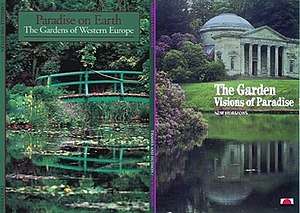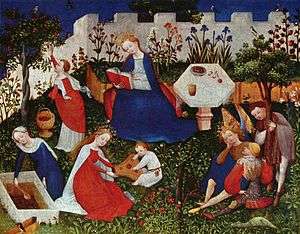Gabrielle van Zuylen
Baroness Gabriëlle Andrée van Zuylen van Nyevely van de Haar (née Iglesias Velayos y Taliaferro; 9 July 1933 – 3 July 2010) was a French landscape architect, garden designer, garden writer and a member of the International Best Dressed Hall of Fame List since 1978.[2] "Baroness Gabrielle van Zuylen personifies the charm and elegance", according to the French magazine L'ŒIL.[3]
Gabrielle van Zuylen | |
|---|---|
 | |
| Born | Gabriëlle Andrée Iglesias Velayos y Taliaferro July 9, 1933 |
| Died | 3 July 2010 (aged 76) |
| Alma mater | Radcliffe College |
| Occupation | Garden designer, garden writer |
Notable work | Jardins privés en France Les jardins de Russell Page Tous les jardins du monde |
| Spouse(s) | Thierry van Zuylen |
| Children | Alexandra van Zuylen, Marina van Zuylen, Helena van Zuylen, Vanessa van Zuylen |
| Awards | Prix de l'Académie française[1] |
Biography
Gabrielle van Zuylen was born in southern France, daughter of Andrés Iglesias y Velayos, the Spanish consul in Perpignan, and his wife Mildred Taliaferro. She grew up in the United States and studied at Radcliffe College. She bears the title baroness van Zuylen as wife of the Dutch baron Thierry van Zuylen van Nyevelt van de Haar since they got married in 1956 in Boston. Although they divorced in 1987, Gabrielle retained the name Van Zuylen.
The Van Zuylen couple bought the property Haras de Varaville in Normandy in 1964. The property consisted of a 17th-century stable and ruins of castles that burned down in 1937. They asked the American architect Peter Harden to build a new home in a modern style. The garden was created and designed by the British landscape architect Russell Page.[4] Gabrielle van Zuylen later wrote the book The Gardens of Russell Page, which is about his influence in landscape architecture. The Garden Writers Association of America named this work ‘best book on gardens’.[5]
She became a specialist on the construction of gardens and published several works about the subject, especially about historic gardens. Her books appeared mostly in French and English and some were also published or translated in other languages. She was a member of the International Dendrology Society, Les Amateurs de Jardins and was a Chevalier of the Order of Agricultural Merit. She was also a gardener.
Interview
An interview between Van Zuylen and Éditions Gallimard took place on the occasion of the publication of Tous les jardins du monde (UK ed. – The Garden: Visions of Paradise), a heavily illustrated pocket book belonging to the collection "Découvertes Gallimard", which gives a concise history of the gardens, from antiquity to the modern day.
Van Zuylen described that pleasure is the primary purpose of a garden, the gardens have always been called "pleasure gardens". There are also three main functions of the garden: the sacred – "sacred enclosure", the place blessed by gods; the power – the great gardens of Cyrus in Persia were wonderful paradises, but also masterful demonstrations of power; the domestic – the small, useful and popular city gardens.[6]
The Romans were the first to have the aesthetic concern of nature, for them, the garden was the counterpart of architecture. In the Middle Ages, the garden also played a very important role, but in another sense: it was walled, protected from the outside. It was the secret garden, the garden of delights, allegory and theatre of love. The large classical gardens of the monarchy at Vaux-le-Vicomte and Versailles, the gardens à la française. In the eighteenth-century England, on the contrary, with the landscape gardens developed by the large landowners which are far from the court. The garden is truly a mirror, the counterpart of the social, political and artistic history of a civilisation.[6]
Tous les jardins du monde
.jpg) 2013 edition | |
| Author | Gabrielle van Zuylen |
|---|---|
| Original title | Tous les jardins du monde |
| Translator | I. Mark Paris |
| Cover artist | Anonymous. Detail from La Nouvelle Maison rustique, Paris, 1735. (FR ed.) Claude Monet's garden at Giverny, France. (US ed.) The Pantheon, Stourhead. (UK ed.) |
| Country | France |
| Language | French |
| Series | Découvertes Gallimard●Art de vivre |
Release number | 207 |
| Subject | History of gardening |
| Genre | Nonfiction monograph |
| Publisher | FR: Éditions Gallimard US: Harry N. Abrams UK: Thames & Hudson |
Publication date | 1994 |
Published in English | 1995 |
| Media type | Print (Paperback) |
| Pages | 176 pp. |
| ISBN | 978-2-070-53241-4 (first edition) |
| OCLC | 858201757 |
| Preceded by | Femmes et religions : Déesses ou servantes de Dieu ? |
| Followed by | Sous la Manche, le tunnel |
| Website | www |

Tous les jardins du monde (lit. "All the Gardens of the World"; in United Kingdom – The Garden: Visions of Paradise; in United States – Paradise on Earth: The Gardens of Western Europe), an elegantly and beautifully illustrated pocket-sized book that treats about the history of Western gardens in a professional way, from antiquity (chap. Ⅰ, "The Gardens of Antiquity and the Legacy of Islam": the Mesopotamian, Persian, Greek and Roman gardens), medieval Europe (chap. Ⅱ, "The Medieval Garden"), Renaissance Italy (chap. Ⅲ, "The Gardens of Renaissance Italy"), Classical France (chap. Ⅳ, "Formality Triumphant: The Classic French Garden"), 18th-century England (chap. Ⅴ, "Planting Pictures: The English Landscape Garden") up to the modern day (chap. Ⅵ, "From Eclecticism to Modernism": for instance, the Parc André Citroën). The book provides numerous historical documents in its second part—the "Documents" section—which contains a compilation of excerpts divided into seven parts: 1, The origins of European gardens; 2, Gardens of the Middle Ages; 3, The Renaissance; 4, The royal gardens of France; 5, Art or nature?; 6, The diversity of 20th-century gardening; 7, Gardens of the New World. At the end of the book are glossary, list of the great European gardens, excerpts from the Florence Charter, further reading, list of illustrations and index. It has been translated into American and British English, Italian, Japanese, Korean, Russian, Turkish, Simplified and Traditional Chinese.
Van Zuylen explains in the book the origin and meaning of a number of historical terms:[7]
- Persian parádeisos: via Alexander the Great the Greeks became familiar with the phenomenon of ornamental garden—the Persian parádeisos—characterised by a watercourse in cross form, the Charbagh.
- Epicureanism: "happiness lies in moderation and refinement", refers to an eponymous philosopher and gardener in ancient Athens.
- Genius loci: originally the place dedicated to a local god (a protective spirit), later the specific attributes or special significance of a piece of landscape.
- Hortus: with the Romans, originally a place for cultivation of vegetables or fruits, later that is combined with water, trellis work and murals. Currently it means "garden" as in horticulture.

It is natural using French sources in an English garden book, especially with regard to the medieval gardens, such as the frescoes from the Palais des Papes in Avignon and illustrations from the Bibliothèque nationale de France. But the author didn't forget to include some German sources, with Paradiesgärtlein being one of them.
It goes without saying that the glory of classical French garden culture and the dynasties of famous garden designers are discussed: Claude and Jacques Mollet (inventor of the parterres de broderie), André Le Nôtre (known for the gardens of Vaux-le-Vicomte, Versailles and the Jardin du Luxembourg).
A less well known figure, Peter Joseph Lenné, a 19th-century Prussian gardener and landscape architect who worked in Potsdam and Berlin (Klein Glienicke, Pfaueninsel and Tiergarten).
Following the Viennese Prater as the first public park, Napoleon III commissioned around 1850 the prefect of the Seine department, baron Georges-Eugène Haussmann to direct the renovation of Paris. Haussmann worked with the engineer Adolphe Alphand and the gardener Jean-Pierre Barillet-Deschamps, they changed the closed hunting forest Bois de Boulogne into a recreation park for the Parisian public. At the same time, Frederick Law Olmsted designed the Central Park in New York City.
Then in the modern times, the beloved gardens of Gertrude Jekyll (Munstead Wood), Vita Sackville-West (Sissinghurst Castle Garden) and Major Lawrence Johnston (Hidcote Manor Garden). The current canon of the good garden: a formal structure in combination with an informal planting, especially the perennials.
Van Zuylen closes her book with a reflection:
Garden-making, like other art forms, draws on the past as it looks to the future. Tradition and innovation are the warp and weft of its history. A garden design is a visual statement of the relationship among human beings, their natural environment and prevailing cultural values […] Gardeners around the world share a common goal: to create a retreat, however limited in space or charm, that offers sanctuary from the tensions of modern life, a place where people can once again relate to nature and feel the pulse of our living, growing planet.[8]
Publications
- Jardins privés en France (collab. with Anita Pereire, Prix Lange), 1983
- The Gardens of Russell Page (collab. with Marina Schinz), 1991
- Tous les jardins du monde, collection « Découvertes Gallimard » (nº 207), série Culture et société. Éditions Gallimard, 1994, new edition in 2013[9]
- The Garden: Visions of Paradise, ‘New Horizons’ series, Thames & Hudson, 1995, reprinted in 2000 (UK edition)
- Paradise on Earth: The Gardens of Western Europe, "Abrams Discoveries" series, Harry N. Abrams, 1995 (U.S. edition)
- Alhambra: A Moorish Paradise, Thames & Hudson, 1999
- Apremont : A French Folly (with Gilles de Brissac), 2004
- Monet's Garden In Giverny, 2009
- Stourhead: English Arcadia
References
- "Gabrielle Van ZUYLEN: Prix de l'Académie" (in French). academie-francaise.fr. Retrieved 2018-01-21.
- "The International Hall of Fame: Women". vanityfair.com. Archived from the original on 2011-09-10. Retrieved 2018-01-21.
- "Les jardins de Gabrielle van Zuylen" [The gardens of Gabrielle van Zuylen]. L'ŒIL (in French). Paris: Éditions Artclair. 1 February 2002. Retrieved 19 October 2018.
- Valéry, Marie-Françoise (1997). Taschen, Angelika (ed.). Gardens in France. Cologne: Benedikt Taschen. pp. 122–127. ISBN 9783836556552.
- Van Zuylen, Gabrielle (1995). Paradise on Earth: The Gardens of Western Europe. “Abrams Discoveries” series. Translated by Paris, I. Mark. New York: Harry N. Abrams. p. 176. ISBN 9780810928510.
About the author
- "Rencontre avec Gabrielle Van Zuylen, à l'occasion de la parution de Tous les jardins du monde (1994)". gallimard.fr (in French). 2004. Retrieved 2018-02-24.
- "The garden – visions of paradise". boekpraat.nl (in Dutch). 2007. Retrieved 19 October 2018.
- Van Zuylen, Gabrielle (1995). "Chapter 6: From Eclecticism to Modernism". The Garden: Visions of Paradise. ‘New Horizons’ series. Translated by Paris, I. Mark. London: Thames & Hudson. pp. 126–127. ISBN 9780500300558.
- "Tous les jardins du monde, collection Découvertes Gallimard (n° 207)". gallimard.fr. Retrieved 2018-01-21.